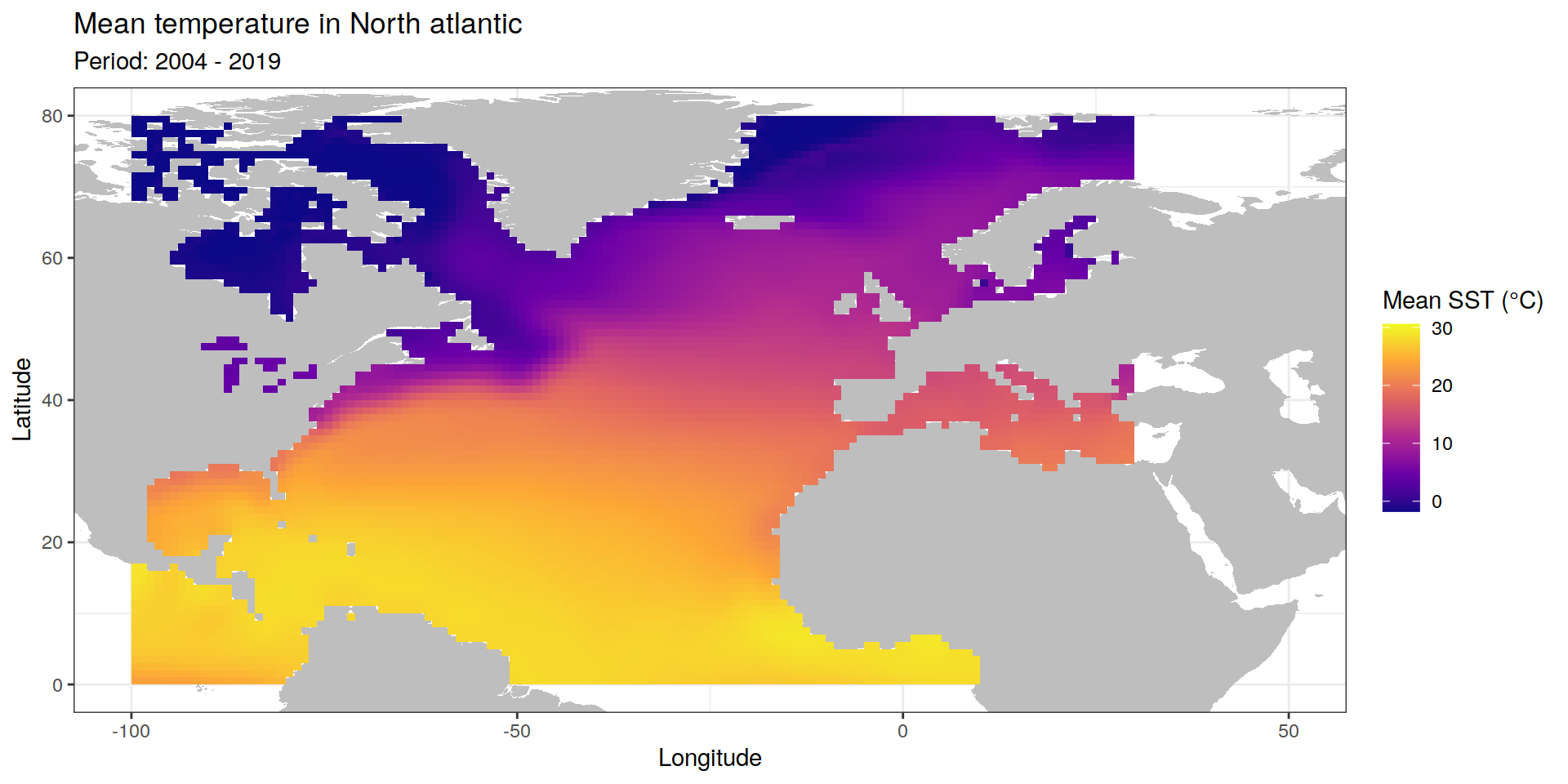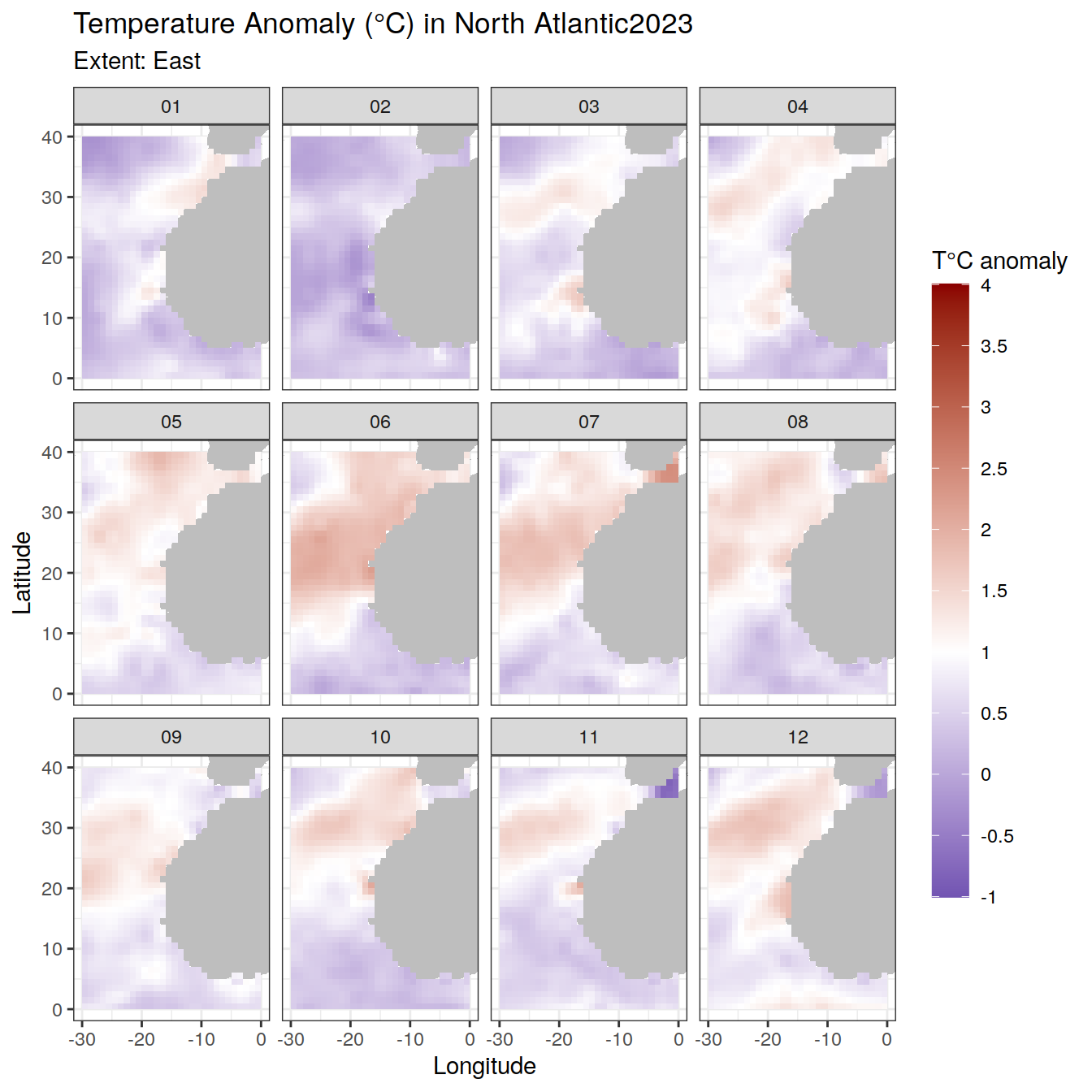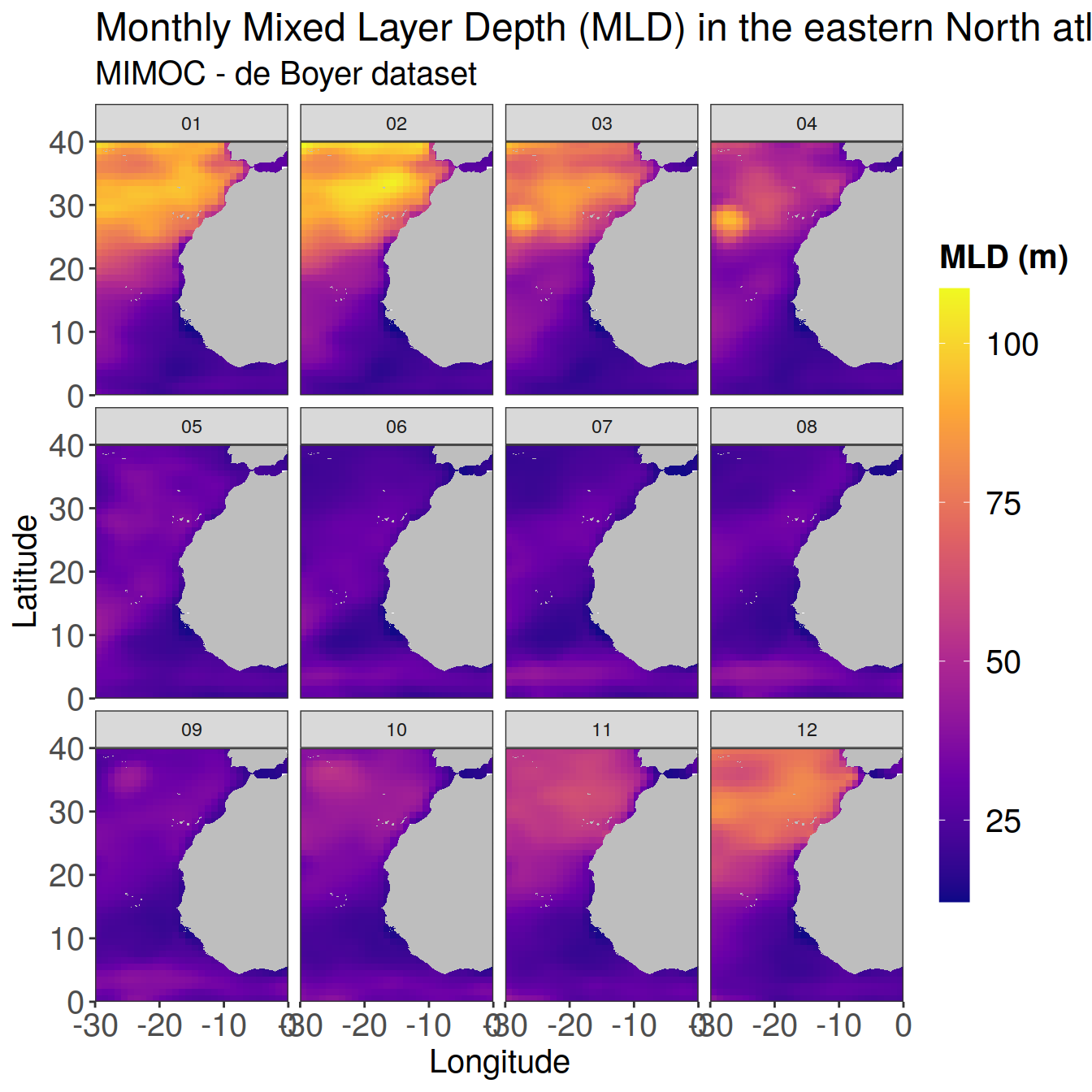Sea Surface Temperature Anomaly
Marguerite Larriere & Jens Daniel Müller
13 June, 2024
Last updated: 2024-06-13
Checks: 7 0
Knit directory:
bgc_argo_r_argodata/analysis/
This reproducible R Markdown analysis was created with workflowr (version 1.7.0). The Checks tab describes the reproducibility checks that were applied when the results were created. The Past versions tab lists the development history.
Great! Since the R Markdown file has been committed to the Git repository, you know the exact version of the code that produced these results.
Great job! The global environment was empty. Objects defined in the global environment can affect the analysis in your R Markdown file in unknown ways. For reproduciblity it’s best to always run the code in an empty environment.
The command set.seed(20211008) was run prior to running
the code in the R Markdown file. Setting a seed ensures that any results
that rely on randomness, e.g. subsampling or permutations, are
reproducible.
Great job! Recording the operating system, R version, and package versions is critical for reproducibility.
Nice! There were no cached chunks for this analysis, so you can be confident that you successfully produced the results during this run.
Great job! Using relative paths to the files within your workflowr project makes it easier to run your code on other machines.
Great! You are using Git for version control. Tracking code development and connecting the code version to the results is critical for reproducibility.
The results in this page were generated with repository version 723b61a. See the Past versions tab to see a history of the changes made to the R Markdown and HTML files.
Note that you need to be careful to ensure that all relevant files for
the analysis have been committed to Git prior to generating the results
(you can use wflow_publish or
wflow_git_commit). workflowr only checks the R Markdown
file, but you know if there are other scripts or data files that it
depends on. Below is the status of the Git repository when the results
were generated:
Ignored files:
Ignored: .RData
Ignored: .Rproj.user/
Ignored: analysis/poster_profile_argo.png
Untracked files:
Untracked: analysis/draft.Rmd
Untracked: load_argo_core_output.txt
Untracked: poster_profile_argo.png
Unstaged changes:
Modified: analysis/CESM_comparison.Rmd
Deleted: analysis/MHWs_categorisation.Rmd
Modified: analysis/MHWs_vertical_anomaly.Rmd
Modified: analysis/_site.yml
Modified: analysis/child/cluster_analysis_base.Rmd
Modified: analysis/coverage_maps_North_Atlantic.Rmd
Modified: analysis/load_broullon_DIC_TA_clim.Rmd
Modified: code/Workflowr_project_managment.R
Modified: code/start_background_job.R
Modified: code/start_background_job_load.R
Modified: code/start_background_job_partial.R
Note that any generated files, e.g. HTML, png, CSS, etc., are not included in this status report because it is ok for generated content to have uncommitted changes.
These are the previous versions of the repository in which changes were
made to the R Markdown (analysis/anomaly_SST_2023.Rmd) and
HTML (docs/anomaly_SST_2023.html) files. If you’ve
configured a remote Git repository (see ?wflow_git_remote),
click on the hyperlinks in the table below to view the files as they
were in that past version.
| File | Version | Author | Date | Message |
|---|---|---|---|---|
| Rmd | 723b61a | mlarriere | 2024-06-13 | cleaning and documenting code |
| html | e49fded | mlarriere | 2024-06-07 | Build site. |
| html | b7e3e82 | mlarriere | 2024-06-07 | Build site. |
| Rmd | 450d23a | mlarriere | 2024-06-07 | mixed layer depth |
| html | 068357b | mlarriere | 2024-06-07 | Build site. |
| Rmd | ea00b64 | mlarriere | 2024-06-07 | mixed layer depth |
| html | 730d809 | mlarriere | 2024-06-06 | Build site. |
| Rmd | deda25c | mlarriere | 2024-06-06 | cleaning code |
| html | 2722ba9 | mlarriere | 2024-06-06 | Build site. |
| Rmd | 38021de | mlarriere | 2024-06-06 | cleaning code |
| html | 711edb9 | mlarriere | 2024-05-15 | Build site. |
| Rmd | c65d468 | mlarriere | 2024-05-15 | East extent map |
| html | 96d4b76 | mlarriere | 2024-05-14 | Build site. |
| html | af6594f | mlarriere | 2024-05-13 | Build site. |
| html | af44bcd | mlarriere | 2024-04-26 | Build site. |
| html | f0289cd | mlarriere | 2024-04-23 | Build site. |
| Rmd | ae8003f | mlarriere | 2024-04-23 | Building test |
| html | 9938047 | mlarriere | 2024-04-22 | Build site. |
| Rmd | 2fc79bb | mlarriere | 2024-04-22 | Adding SST anomaly subsection |
| html | 9cac35e | mlarriere | 2024-04-22 | Build site. |
| Rmd | 86f2f02 | mlarriere | 2024-04-22 | Adding SST anomaly subsection |
Task
Dependencies
VLIZ-SOM_FFN_inputs.nc - Files containing the predictor of the SOM-FFN model. Here we use 2 variables of interest: SST from the HadISST dataset and Mixed Layer Depth (MLD) from the combined dataset MIMOC-deBoyer
Outputs
SST_anomaly2023_NorthAtlantic_clim2004-2019.rds - file with the SST anomalies for 2023 using HadISST computed climatology mld_2023_eastern_NorthAtlantic.rds - file containing the mld values for the eastern North Atlantic in 2023
#Area of interest: North Atlantic north west - lat:(60,30), lon:(-70,-30), North Atlantic east - lat:(0,40), lon:(-30,0)
chosen_extent <- list(
lat_min = 0, #30
lat_max = 40, #60
lon_min = -30, #-70
lon_max = 0 #-30
)
name_extent<- "East" #Northwest
#base map for the plots
world_coordinates <- map_data("world")
#year of interest
target_year<-2023#Paths
path_emlr_utilities <- "/nfs/kryo/work/jenmueller/emlr_cant/utilities/files/"
path_basin_mask <- "/nfs/kryo/work/datasets/gridded/ocean/interior/reccap2/supplementary/"
path_argo <- '/nfs/kryo/work/datasets/ungridded/3d/ocean/floats/bgc_argo'
path_argo_core <- '/nfs/kryo/work/datasets/ungridded/3d/ocean/floats/core_argo_r_argodata_2024-03-13'
path_argo_core_preprocessed <- paste0(path_argo_core, "/preprocessed_core_data")
path_argo_preprocessed <- paste0(path_argo, "/preprocessed_bgc_data")
path_basin_mask <- "/nfs/kryo/work/datasets/gridded/ocean/interior/reccap2/supplementary/"
path_pCO2_products <- "/nfs/kryo/work/datasets/gridded/ocean/2d/observation/pco2/"Sea Surface Temperature
Load data and create climatology 2004-2019 (mean value)
#Read HadISST dataset - SST: variable of interest
pco2_product <- read_ncdf(paste0(path_pCO2_products, "VLIZ-SOM_FFN/VLIZ-SOM_FFN_inputs.nc"),
var = "sst",
ignore_bounds = TRUE,
make_units = FALSE)
pco2_product <- pco2_product %>%
as_tibble()
pco2_product <- pco2_product %>%
mutate(across(-c(lon, lat, time), ~ replace(., . >= 1e+19, NA)))
# Extract data for each 15th of the month
pco2_product <- pco2_product %>%
mutate(year = year(time),
month = factor(format(time, "%m")),
date = time)
#Extract data for computing the climatology: period 2004-2019 to match with BOA-Argo.
sst_2004_2019_natlantic<- pco2_product %>%
filter(year>2004, year<2019, !is.na(sst), lat > 0, lon <30, lon >-100)
#Create climatology
climato_2004_2019<-sst_2004_2019_natlantic %>%
group_by(month, lat, lon) %>%
summarize(mean_temp=mean(sst, na.rm=TRUE))SST map
#Plot the SST climatology from the HadISST
mean_temperature_map<- ggplot()+
geom_map(data = world_coordinates, map = world_coordinates, aes(long, lat, map_id = region), fill = "grey") + #base map
lims(x= c(-100, 50), y = c(0, 80))+ #North Atlantic
geom_tile(data=climato_2004_2019, aes(x = lon, y = lat, fill = mean_temp)) +
scale_fill_viridis_c(option='plasma') +
labs(title= "Mean temperature in North atlantic",
subtitle= "Period: 2004 - 2019",
x = "Longitude", y = "Latitude", fill = "Mean SST (°C)") +
theme(legend.position = 'right')
print(mean_temperature_map)
SST anomaly map
#HadISST SST output for 2023 in North Atlantic
sst_2023_natlantic<- pco2_product %>%
filter(year==target_year, !is.na(sst), lat > 0, lon <30, lon >-100)
merged_data <- merge(sst_2023_natlantic, climato_2004_2019, by = c("month", "lat", "lon")) %>%
as.tibble()
merged_data$SST_anomaly<- merged_data$sst - merged_data$mean_temp
sst_anomaly_2023_natlantic<-merged_data %>%
select(lat,lon, month, SST_anomaly)
# Plots anomaly map in the North Atlantic Ocean
anomaly_sst_2023_map <- ggplot()+
geom_map(data = world_coordinates, map = world_coordinates, aes(long, lat, map_id = region), fill = "grey") + #base map
lims(x= c(-100, 50), y = c(0, 80))+ #North Atlantic
geom_tile(data=sst_anomaly_2023_natlantic, aes(x = lon, y = lat, fill = SST_anomaly)) +
scale_fill_gradient2(name='T°C anomaly', low = "darkblue", high = "darkred")+
labs(title = "Temperature Anomaly per month in North Atlantic (2023)",
subtitle = "climatology 2004-2019",
x = "Longitude", y = "Latitude") +
theme(legend.position = 'right', legend.key.height = unit(2, "cm")) +
facet_wrap(~ month, ncol=2)
print(anomaly_sst_2023_map)
Area of interest
We focus our study on the eastern North Atlantic ocean, region showing a persistent MHW throughout 2023.
#------Defining area of interest spatially and temporally depending on SST anomaly
#Annual hotspot (+MAM + JJA + a bit SON) in agreement with climate reanaliser
east_sst_anomaly<-sst_anomaly_2023_natlantic%>%
filter(lat > chosen_extent$lat_min, lat < chosen_extent$lat_max,
lon > chosen_extent$lon_min, lon < chosen_extent$lon_max)
#Plot SST anomaly
map_anomaly_east <- ggplot()+
geom_map(data = world_coordinates, map = world_coordinates, aes(long, lat, map_id = region), fill = "grey") + #base map
lims(x= c(chosen_extent$lon_min, chosen_extent$lon_max),
y = c(chosen_extent$lat_min, chosen_extent$lat_max))+ #North Atlantic
geom_tile(data=east_sst_anomaly, aes(x = lon, y = lat, fill = SST_anomaly)) +
scale_fill_gradient2(name='T°C anomaly', low = "darkblue", high = "darkred",
midpoint = 1,
breaks = seq(-1, 4, by = 0.5), labels = as.character(seq(-1, 4, by = 0.5)),
limits = c(-1, 4))+
labs(title = paste0("Temperature Anomaly (°C) in North Atlantic", target_year),
subtitle = paste0("Extent: ", name_extent),
x = "Longitude", y = "Latitude") +
theme(legend.position = 'right',
legend.key.height = unit(2, "cm")) +
facet_wrap(~ month, ncol=4)
print(map_anomaly_east)
Write file
write_rds(sst_anomaly_2023_natlantic,
file = paste0(path_argo_core_preprocessed,"/",
"SST_anomaly", target_year,"_NorthAtlantic_clim2004-2019.rds"))Mixed Layer Depth (MLD)
The MLD data comes from the combined dataset MIMOC-deBoyer
#Read MLD data units: [ln(re 1 m)]
pco2_product <- read_ncdf(paste0(path_pCO2_products, "VLIZ-SOM_FFN/VLIZ-SOM_FFN_inputs.nc"),
var = "mld",
ignore_bounds = TRUE,
make_units = FALSE)
pco2_product <- pco2_product %>%
as_tibble()
pco2_product <- pco2_product %>%
mutate(across(-c(lon, lat, time), ~ replace(., . >= 1e+19, NA)))
#unit transformation
pco2_product <- pco2_product %>%
mutate(mld=exp(mld))
# Extract data for each 15th of the month
pco2_product <- pco2_product %>%
mutate(year = year(time),
month = factor(format(time, "%m")),
date = time)
# Extract MLD for the eastern North Atlantic region
mld_eastern_NorthAtltantic<-pco2_product %>%
filter(!is.na(mld),
lat > chosen_extent$lat_min, lat < chosen_extent$lat_max,
lon > chosen_extent$lon_min, lon < chosen_extent$lon_max)
# Select only data in 2023
mld_eastern_NorthAtltantic_2023<-mld_eastern_NorthAtltantic %>%
filter(year==target_year)#plot MLD values in the eastern North Atlantic
ggplot()+
geom_tile(data=mld_eastern_NorthAtltantic_2023, aes(x = lon, y = lat, fill = mld )) +
geom_map(data = world_coordinates, map = world_coordinates, aes(long, lat, map_id = region), fill = "grey") + #base map
lims(x = c(chosen_extent$lon_min, chosen_extent$lon_max), y=c(chosen_extent$lat_min, chosen_extent$lat_max)) +
coord_cartesian(expand = 0)+
scale_fill_viridis_c(option='plasma') +
labs(title= "Monthly Mixed Layer Depth (MLD) in the eastern North atlantic - 2023",
subtitle= 'MIMOC - de Boyer dataset',
x = "Longitude", y = "Latitude", fill = "MLD (m)") +
facet_wrap(~month)+
theme(plot.title = element_text(size = 18),
plot.subtitle = element_text(size = 15),
axis.title.x = element_text(size = 15),
axis.title.y = element_text(size = 15),
axis.text.x = element_text(size = 15),
axis.text.y = element_text(size = 15),
legend.text = element_text(size = 15),
legend.title = element_text(size = 15, face = "bold"),
legend.key.width = unit(0.5, "cm"),
legend.key.height = unit(2, "cm"))+
theme(legend.position = 'right')
# Computing the mean MLD on a 2 month basis over the eastern North Atlantic in 2023
mld_eastern_NorthAtltantic_2023_2months <- mld_eastern_NorthAtltantic_2023 %>%
mutate(period=(as.numeric(month)+1)%/%2) %>%
group_by(period, lat, lon) %>%
summarize(mean_mld=mean(mld, na.rm=TRUE))
#plot
ggplot()+
geom_tile(data=mld_eastern_NorthAtltantic_2023_2months, aes(x = lon, y = lat, fill = mean_mld )) +
geom_map(data = world_coordinates, map = world_coordinates, aes(long, lat, map_id = region), fill = "grey") + #base map
lims(x = c(chosen_extent$lon_min, chosen_extent$lon_max), y=c(chosen_extent$lat_min, chosen_extent$lat_max)) +
coord_cartesian(expand = 0)+
scale_fill_viridis_c(option='plasma') +
labs(title= "Mean Mixed Layer Depth in the eastern North atlantic - 2023",
subtitle = '2months average',
x = "Longitude", y = "Latitude", fill = "Mixed Layer Depth (m)") +
facet_wrap(~period, nrow = 3)+
theme(legend.position = 'right')
Write file
write_rds(mld_eastern_NorthAtltantic_2023,
file = paste0(path_argo_core_preprocessed,"/",
"mld_", target_year,"_eastern_NorthAtlantic.rds"))
sessionInfo()R version 4.2.2 (2022-10-31)
Platform: x86_64-pc-linux-gnu (64-bit)
Running under: openSUSE Leap 15.5
Matrix products: default
BLAS: /usr/local/R-4.2.2/lib64/R/lib/libRblas.so
LAPACK: /usr/local/R-4.2.2/lib64/R/lib/libRlapack.so
locale:
[1] LC_CTYPE=en_US.UTF-8 LC_NUMERIC=C
[3] LC_TIME=en_US.UTF-8 LC_COLLATE=en_US.UTF-8
[5] LC_MONETARY=en_US.UTF-8 LC_MESSAGES=en_US.UTF-8
[7] LC_PAPER=en_US.UTF-8 LC_NAME=C
[9] LC_ADDRESS=C LC_TELEPHONE=C
[11] LC_MEASUREMENT=en_US.UTF-8 LC_IDENTIFICATION=C
attached base packages:
[1] stats graphics grDevices utils datasets methods base
other attached packages:
[1] RColorBrewer_1.1-3 stars_0.6-0 sf_1.0-9
[4] abind_1.4-5 broom_1.0.5 paletteer_1.6.0
[7] cluster_2.1.6 gridExtra_2.3 scatterplot3d_0.3-44
[10] viridis_0.6.2 viridisLite_0.4.1 ggOceanMaps_1.3.4
[13] ggspatial_1.1.7 oce_1.7-10 gsw_1.1-1
[16] lubridate_1.9.0 timechange_0.1.1 forcats_0.5.2
[19] stringr_1.5.0 dplyr_1.1.3 purrr_1.0.2
[22] readr_2.1.3 tidyr_1.3.0 tibble_3.2.1
[25] ggplot2_3.4.4 tidyverse_1.3.2 workflowr_1.7.0
loaded via a namespace (and not attached):
[1] googledrive_2.0.0 colorspace_2.0-3 ellipsis_0.3.2
[4] class_7.3-20 rprojroot_2.0.3 fs_1.5.2
[7] rstudioapi_0.15.0 proxy_0.4-27 farver_2.1.1
[10] fansi_1.0.3 xml2_1.3.3 codetools_0.2-18
[13] cachem_1.0.6 knitr_1.41 jsonlite_1.8.3
[16] dbplyr_2.2.1 rgeos_0.5-9 compiler_4.2.2
[19] httr_1.4.4 backports_1.4.1 assertthat_0.2.1
[22] fastmap_1.1.0 gargle_1.2.1 cli_3.6.1
[25] later_1.3.0 htmltools_0.5.8.1 tools_4.2.2
[28] gtable_0.3.1 glue_1.6.2 maps_3.4.1
[31] Rcpp_1.0.10 cellranger_1.1.0 jquerylib_0.1.4
[34] RNetCDF_2.6-1 raster_3.6-11 vctrs_0.6.4
[37] lwgeom_0.2-10 xfun_0.35 ps_1.7.2
[40] rvest_1.0.3 lifecycle_1.0.3 ncmeta_0.3.5
[43] googlesheets4_1.0.1 terra_1.7-65 getPass_0.2-2
[46] scales_1.2.1 hms_1.1.2 promises_1.2.0.1
[49] parallel_4.2.2 rematch2_2.1.2 yaml_2.3.6
[52] sass_0.4.4 stringi_1.7.8 highr_0.9
[55] e1071_1.7-12 rlang_1.1.1 pkgconfig_2.0.3
[58] evaluate_0.18 lattice_0.20-45 labeling_0.4.2
[61] processx_3.8.0 tidyselect_1.2.0 magrittr_2.0.3
[64] R6_2.5.1 generics_0.1.3 DBI_1.2.2
[67] pillar_1.9.0 haven_2.5.1 whisker_0.4
[70] withr_2.5.0 units_0.8-0 sp_1.5-1
[73] modelr_0.1.10 crayon_1.5.2 KernSmooth_2.23-20
[76] utf8_1.2.2 tzdb_0.3.0 rmarkdown_2.18
[79] grid_4.2.2 readxl_1.4.1 callr_3.7.3
[82] git2r_0.30.1 reprex_2.0.2 digest_0.6.30
[85] classInt_0.4-8 httpuv_1.6.6 munsell_0.5.0
[88] bslib_0.4.1